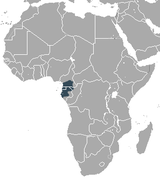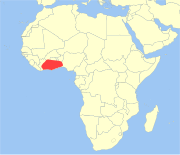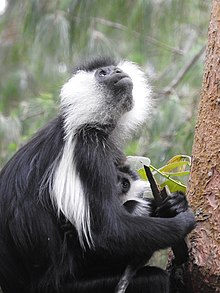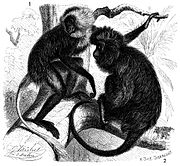| Black-and-white colobus | |
|---|---|

| |
| Mantled guereza (Colobus guereza) | |
| Scientific classification | |
| Domain: | Eukaryota |
| Kingdom: | Animalia |
| Phylum: | Chordata |
| Class: | Mammalia |
| Order: | Primates |
| Suborder: | Haplorhini |
| Infraorder: | Simiiformes |
| Family: | Cercopithecidae |
| Subfamily: | Colobinae |
| Tribe: | Colobini |
| Genus: | Colobus Illiger, 1811 |
| Type species | |
| Simia polycomos Schreber, 1800 (= Cebus polykomos Zimmermann, 1780) | |
| Species | |
| |
Black-and-white colobuses (or colobi) are Old World monkeys of the genus Colobus, native to Africa. They are closely related to the red colobus monkeys of genus Piliocolobus. There are five species of this monkey, and at least eight subspecies. They are generally found in high-density forests where they forage on leaves, flowers and fruit. Social groups of colobus are diverse, varying from group to group. Resident-egalitarian and allomothering relationships have been observed among the female population. Complex behaviours have also been observed in this species, including greeting rituals and varying group sleeping patterns. Colobi play a significant role in seed dispersal.
Etymology
The word "colobus" comes from the Greek κολοβός (kolobós, "docked", "maimed") and refers to the stump-like thumb.
Taxonomy
| Common name | Scientific name and subspecies | Range | Size and ecology | IUCN status and estimated population |
|---|---|---|---|---|
| Angola colobus | C. angolensis P. L. Sclater, 1860 Six subspecies
|
Central Africa
|
Size: 49–68 cm (19–27 in) long, plus 70–83 cm (28–33 in) tail Habitat: Forest Diet: Leaves, as well as stems, bark, flowers, buds, shoots, fruits, and insects |
VU
|
| Black colobus | C. satanas Waterhouse, 1838 Two subspecies
|
Western Africa
|
Size: 50–70 cm (20–28 in) long, plus 62–88 cm (24–35 in) tail Habitat: Forest Diet: Nuts and seeds, as well as unripe fruit and leaves |
VU
|
| King colobus | C. polykomos (Zimmermann, 1780) |
Western Africa
|
Size: 45–72 cm (18–28 in) long, plus 52–100 cm (20–39 in) tail Habitat: Forest and savanna Diet: Leaves, as well as fruit and flowers |
EN
|
| Mantled guereza | C. guereza Rüppell, 1835 Seven subspecies
|
Central Africa
|
Size: 45–72 cm (18–28 in) long, plus 52–100 cm (20–39 in) tail Habitat: Forest Diet: Leaves, as well as fruit, buds, and blossoms |
LC
|
| Ursine colobus | C. vellerosus (I. Geoffroy, 1834) |
Western Africa
|
Size: 60–67 cm (24–26 in) long, plus 73–93 cm (29–37 in) tail Habitat: Forest Diet: Leaves and seeds, as well as fruit, insects, and clay |
CR
|
Fossil species
Behaviour and ecology

Colobus habitats include primary and secondary forests, riverine forests, and wooded grasslands; they are found more in higher-density logged forests than in other primary forests. Their ruminant-like digestive systems have enabled them to occupy niches that are inaccessible to other primates: they are herbivorous, eating leaves, fruit, flowers, lichen, herbaceous vegetation and bark. Colobuses are important for seed dispersal through their sloppy eating habits, as well as through their digestive systems.
Leaf toughness influences colobus foraging efficiency. Tougher leaves correlate negatively with ingestion rate (g/min) as they are costly in terms of mastication, but positively with investment (chews/g). Individuals spend approximately 150 minutes actively feeding each day. In a montane habitat colobus are known to utilise lichen as a fallback food during periods of low food availability.
Social patterns and morphology
Colobuses live in territorial groups that vary in both size (3-15 individuals) and structure. It was originally believed that the structure of these groups consisted of one male and about 8 female members. However, more recent observations have shown variation in structure and the number of males within groups, with one species forming multi-male, multifemale groups in a multilevel society, and in some populations supergroups form exceeding 500 individuals. There appears to be a dominant male, whilst there is no clear dominance among female members. Relationships among females are considered to be resident-egalitarian, as there is low competition and aggression between them within their own groups. Juveniles are treated as a lower-rank (in regards to authority) than subadults and likewise when comparing subadults to adults. Colobuses do not display any type of seasonal breeding patterns.
As suggested by their name, adult colobi have black fur with white features. White fur surrounds their facial region and a "U" shape of long white fur runs along the sides of their body. Newborn colobi are completely white with a pink face. Cases of allomothering are documented, which means members of the troop other than the infant's biological mother care for it. Allomothering is believed to increase inclusive fitness or maternal practice for the benefit of future offspring.
Social behaviours

Many members participate in a greeting ritual when they are reunited with familiar individuals, an act of reaffirming. The greeting behaviour is generally carried out by the approaching monkey and often is followed with grooming. They participate in three greeting behaviours of physical contact. This includes mounting, head mounting (grasps the shoulders) and embracing. It seems as though these behaviours do not have any relationship with mating or courting.

Black-and-white colobus have complex sleeping patterns. They sleep in trees near a food source, which may serve to save energy. Groups seem to regularly switch up sleeping locations (suggested due to reducing risk of parasites and placement prediction) and generally do not sleep near other groups. They also tend to sleep more tightly together on nights with great visibility. They sleep in mid- to upper sections of tall trees which allows for predator watch as well as protection from ground and aerial predators while they are asleep. Although there is no obvious preference for tree type, they have often been observed in Antiaris toxicaria.
Conservation
They are prey for many forest predators such as leopards and chimpanzees, and are threatened by hunting for the bushmeat trade, logging, and habitat destruction.
Individuals are more vigilant (conspecific threat) in low canopy, they also spend less time scanning when they are around familiar group members as opposed to unfamiliar. There are no clear difference in vigilance between male and females. However, there is a positive correlation between mean monthly vigilance and encounter rates. Male vigilance generally increases during mating.
References
- ^ Groves, C. P. (2005). Wilson, D. E.; Reeder, D. M. (eds.). Mammal Species of the World: A Taxonomic and Geographic Reference (3rd ed.). Baltimore: Johns Hopkins University Press. pp. 167–168. ISBN 0-801-88221-4. OCLC 62265494.
- ^ Kutsukake, Nobuyuki; Suetsugu, Noyuri; Hasegawa, Toshikazu (2006-11-16). "Pattern, Distribution, and Function of Greeting Behavior Among Black-and-White Colobus". International Journal of Primatology. 27 (5): 1271–1291. doi:10.1007/s10764-006-9072-x. ISSN 0164-0291. S2CID 24835234.
- ^ Sterck, Elisabeth H. M.; Watts, David P.; van Schaik, Carel P. (1997-11-20). "The evolution of female social relationships in nonhuman primates". Behavioral Ecology and Sociobiology. 41 (5): 291–309. doi:10.1007/s002650050390. hdl:1874/1183. ISSN 0340-5443. S2CID 25163826.
- ^ Von Hippel, Frank A. (1998). "Use of sleeping trees by black and white Colobus monkeys (Colobus guereza) in the Kakamega Forest, Kenya". American Journal of Primatology. 45 (3): 281–290. doi:10.1002/(sici)1098-2345(1998)45:3<281::aid-ajp4>3.0.co;2-s. ISSN 0275-2565. PMID 9651650.
- ^ Thompson, Brandon (2002). "Colobus angolensis". Animal Diversity Web. University of Michigan. Archived from the original on August 12, 2023. Retrieved July 24, 2023.
- ^ de Jong, Y. A.; Cunneyworth, P.; Butynski, T. M.; Maisels, F.; Hart, J. A.; Rovero, F. (2020). "Colobus angolensis". IUCN Red List of Threatened Species. 2020: e.T5142A17945007. doi:10.2305/IUCN.UK.2020-2.RLTS.T5142A17945007.en.
- ^ Lane, Whitney (2011). "Colobus satanas". Animal Diversity Web. University of Michigan. Archived from the original on August 12, 2023. Retrieved July 24, 2023.
- ^ Maisels, F.; Cronin, D. T. (2020). "Colobus satanas". IUCN Red List of Threatened Species. 2020: e.T5145A17944405. doi:10.2305/IUCN.UK.2020-2.RLTS.T5145A17944405.en.
- ^ Landes, Devon (2000). "Colobus polykomos". Animal Diversity Web. University of Michigan. Archived from the original on August 12, 2023. Retrieved July 24, 2023.
- ^ Gonedelé Bi, S.; Koné, I.; Matsuda Goodwin, R.; Alonso, C.; Hernansaiz, A.; Oates, J. F. (2020). "Colobus polykomos". IUCN Red List of Threatened Species. 2020: e.T5144A17944855. doi:10.2305/IUCN.UK.2020-2.RLTS.T5144A17944855.en.
- ^ Kim, Kenneth (2002). "Colobus guereza". Animal Diversity Web. University of Michigan. Archived from the original on August 12, 2023. Retrieved July 24, 2023.
- ^ de Jong, Y. A.; Butynski, T. M.; Oates, J. F. (2019). "Colobus guereza". IUCN Red List of Threatened Species. 2019: e.T5143A17944705. doi:10.2305/IUCN.UK.2019-3.RLTS.T5143A17944705.en.
- Kingdon 2015, p. 114
- ^ Matsuda Goodwin, R.; Gonedelé Bi, S.; Nobimè, G.; Koné, I.; Osei, D.; Segniagbeto, G.; Oates, J. F. (2020). "Colobus vellerosus". IUCN Red List of Threatened Species. 2020: e.T5146A169472127. doi:10.2305/IUCN.UK.2020-2.RLTS.T5146A169472127.en.
- Walker, Shannon (2009). "Colobus vellerosus". Animal Diversity Web. University of Michigan. Archived from the original on August 4, 2020. Retrieved July 24, 2023.
- ^ Dunham, Noah T.; Lambert, Alexander L. (2016). "The role of leaf toughness on foraging efficiency in Angola black and white colobus monkeys ( Colobus angolensis palliatus ): Dunham and Lambert". American Journal of Physical Anthropology. 161 (2): 343–354. doi:10.1002/ajpa.23036. PMID 27346431.
- Miller, A.; Judge, D.; Uwingeneye, G.; Ndayishimiye, D.; Grueter, C. C. (2020). "Diet and Use of Fallback Foods by Rwenzori Black-and-White Colobus (Colobus angolensis ruwenzorii) in Rwanda: Implications for Supergroup Formation". International Journal of Primatology. 41 (3): 434–457. doi:10.1007/s10764-020-00143-w. S2CID 212731904.
- ^ Miller, A.; Uddin, S.; Judge, D. S.; Kaplin, B. A.; Ndayishimiye, D.; Uwingeneye, G.; Grueter, C. C. (2020). "Spatiotemporal association patterns in a supergroup of Rwenzori black-and-white colobus (Colobus angolensis ruwenzorii) are consistent with a multilevel society". American Journal of Primatology. 82 (6): e23127. doi:10.1002/ajp.23127. PMID 32249977. S2CID 214808996.
- ^ Stead, S. M.; Teichroeb, J. A. (2019). "A multi-level society comprised of one-male and multi-male core units in an African colobine (Colobus angolensis ruwenzorii)". PLOS ONE. 14 (10): e0217666. doi:10.1371/journal.pone.0217666. PMC 6795445. PMID 31618212.
- Marler, Peter (1972). "Vocalizations of East African Monkeys II: Black and White Colobus". Behaviour. 42 (3–4): 175–197. doi:10.1163/156853972x00266. ISSN 0005-7959.
- Teichroeb, Julie A.; Sicotte, Pascale (2009). "Test of the ecological-constraints model on ursine colobus monkeys (Colobus vellerosus) in Ghana". American Journal of Primatology. 71 (1): 49–59. doi:10.1002/ajp.20617. ISSN 0275-2565. PMID 18828147. S2CID 31872244.
- Dunham, Noah Thomas; Opere, Paul Otieno (2016-02-12). "A unique case of extra-group infant adoption in free-ranging Angola black and white colobus monkeys (Colobus angolensis palliatus)". Primates. 57 (2): 187–194. doi:10.1007/s10329-016-0515-5. ISSN 0032-8332. PMID 26872896. S2CID 14120148.
- ^ MacIntosh, Andrew J.J.; Sicotte, Pascale (2009). "Vigilance in ursine black and white colobus monkeys ( Colobus vellerosus ): an examination of the effects of conspecific threat and predation". American Journal of Primatology. 71 (11): 919–927. doi:10.1002/ajp.20730. PMID 19598222. S2CID 205329258.
- Baldellou, Maribel; Peter Henzi, S. (1992). "Vigilance, predator detection and the presence of supernumerary males in vervet monkey troops". Animal Behaviour. 43 (3): 451–461. doi:10.1016/s0003-3472(05)80104-6. ISSN 0003-3472. S2CID 53202789.
Sources
- Kingdon, Jonathan (2015). The Kingdon Field Guide to African Mammals (Second ed.). Bloomsbury Publishing. ISBN 978-1-4729-2531-2.
External links
- Colobus Monkey: Wildlife summary from the African Wildlife Foundation
- Colobus Conservation
- Primate Info Net Colobus Factsheets
- Angolan Black & White Colobus
| Haplorhini | |||||||||||||||||||||||||||||||||||||||||||||
|---|---|---|---|---|---|---|---|---|---|---|---|---|---|---|---|---|---|---|---|---|---|---|---|---|---|---|---|---|---|---|---|---|---|---|---|---|---|---|---|---|---|---|---|---|---|
| |||||||||||||||||||||||||||||||||||||||||||||
| |||||||||||||||||||||||||||||||||||||||||||||
| |||||||||||||||||||||||||||||||||||||||||||||
| |||||||||||||||||||||||||||||||||||||||||||||
| Taxon identifiers | |
|---|---|
| Colobus | |








